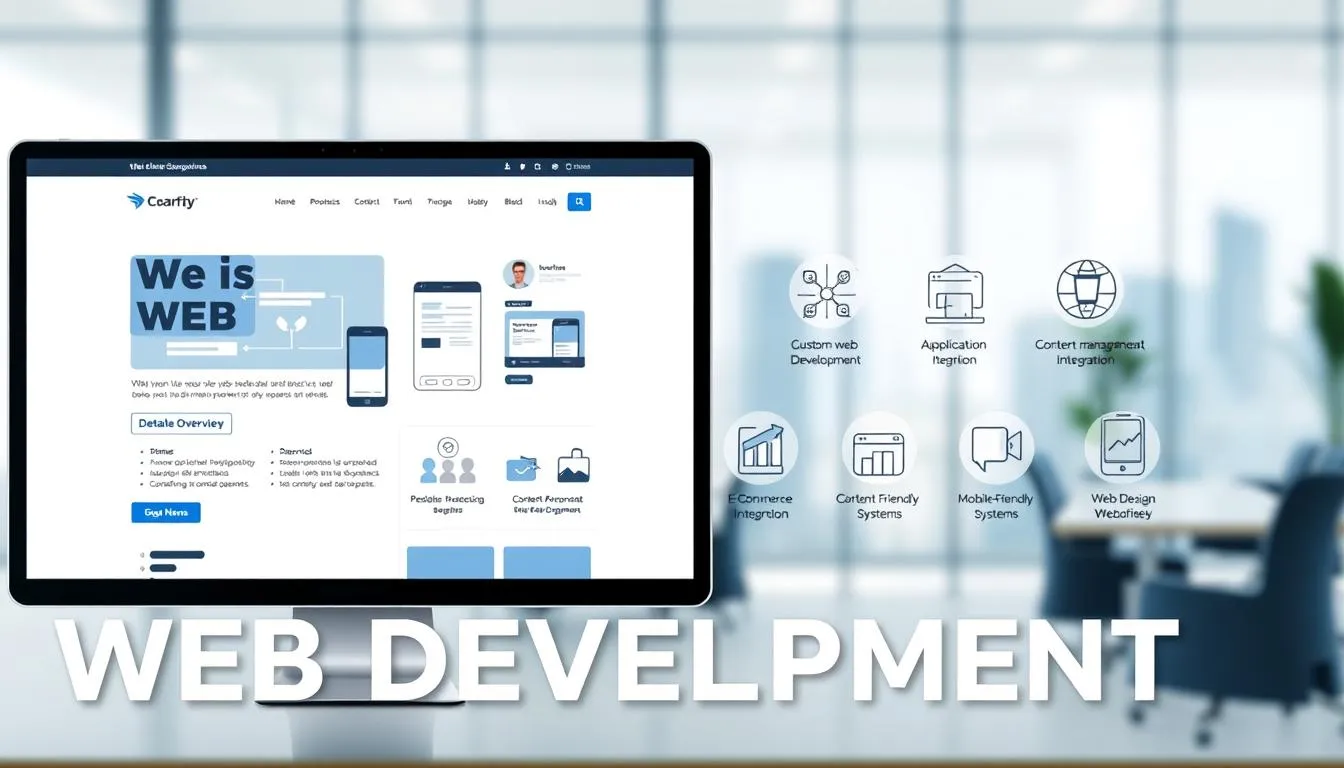Remember the last time you clicked away from a slow, confusing webpage? That moment of frustration is exactly what your customers feel when your digital space doesn’t reflect your brand’s value. In today’s fast-paced world, your online presence isn’t just a placeholder—it’s the heartbeat of your business relationships.
Imagine a local bakery owner who doubled her orders after revamping her site with clear menus and seamless checkout. Stories like this show how strategic digital solutions transform clicks into connections. Companies like Netguru have helped brands achieve 24% more site traffic and 54% higher user engagement—proof that thoughtful execution matters.
Creating a standout digital experience goes beyond aesthetics. It’s about blending visual appeal with functionality that keeps visitors engaged. Whether you’re a entrepreneurs or an established enterprise, every element—from navigation speed to mobile responsiveness—shapes how audiences perceive your credibility.
Our team combines six years of industry expertise with AI-powered tools to craft platforms that align with your goals. Like Appnovation’s client-focused approach, we prioritize solutions that drive real-world results, ensuring your brand doesn’t just exist online—it thrives there.
Key Takeaways
-
Your digital foundation directly impacts customer trust and business growth
-
High-performing platforms balance visual appeal with technical precision
-
user experience improvements can significantly boost engagement metrics
-
Strategic planning accounts for industry trends and audience behaviors
-
Proven partners deliver measurable outcomes through tailored solutions
Overview of website design and development services
Ever wondered what separates a forgettable digital space from one that converts visitors into loyal customers? Modern solutions blend technical precision with creative storytelling to build platforms that exceed expectations. From initial brainstorming to post-launch tweaks, every phase matters.

Today’s offerings go far beyond basic page creation. Teams now handle:
| Phase | Key Activities | Outcome |
|---|---|---|
| Ideation | Market research, prototyping | Validated concept |
| Design | UI/UX optimization, responsive layouts | User-friendly interface |
| Deployment | Security audits, performance checks | Market-ready platform |
Specialized options like custom ecommerce tools help businesses scale. Imagine having payment gateways that adapt to your inventory growth or CMS platforms tailored to your workflow. These aren’t luxuries—they’re necessities in competitive markets.
Ongoing support ensures platforms stay sharp. Regular updates and 24/7 monitoring keep technical hiccups from disrupting operations. Think of it as having a pit crew for your digital racecar—always ready to optimize performance.
The Role of Web Development in Elevating Your Online Presence
How often do visitors stay engaged versus bouncing within seconds? The difference lies in technical execution that turns ideas into interactive experiences. Like a chef perfecting a recipe, skilled developers blend code and creativity to serve digital solutions that keep audiences coming back.

Strategic development acts as your brand’s digital architect. It builds frameworks that adapt to user needs while boosting visibility. Consider these critical components:
| Focus Area | Technical Requirements | business Impact |
|---|---|---|
| Performance Optimization | Code efficiency, caching systems | Faster load times = higher retention |
| Cross-Device Compatibility | responsive design testing | Consistent experiences = stronger trust |
| SEO Integration | Structured data markup | Better rankings = increased discovery |
Modern platforms need more than basic functionality. Analytics tools track user journeys, revealing which features drive conversions. Scalable infrastructure handles traffic spikes during promotions or seasonal demands without crashing.
Did you know 53% of mobile users abandon sites taking over 3 seconds to load? Professional coding practices prevent such losses. They ensure seamless interactions across browsers and devices—key for maintaining credibility in competitive markets.
Ongoing maintenance keeps digital assets sharp. Security patches and feature updates work behind the scenes like invisible brand ambassadors. This proactive approach turns static pages into dynamic growth engines.
Modern Web Technologies and Frameworks
Just as master chefs rely on quality ingredients, today’s digital creators depend on cutting-edge tools to deliver exceptional results. The right technology stack acts like a precision toolkit—each component working in harmony to build platforms that outperform expectations.

Frontend & Backend Powerhouses
Industry leaders combine React’s dynamic interface capabilities with Angular’s structured approach for fluid user interactions. On the server side, Node.js handles real-time data flows while Laravel streamlines complex operations. This synergy creates platforms that feel effortless to users yet robust behind the scenes.
| Technology | Primary Use | Performance Benefit |
|---|---|---|
| React | Interactive UI components | Faster rendering |
| Node.js | Server-side scripting | High concurrency handling |
| Laravel | Database management | Simplified CRUD operations |
Core Web Language Optimization
HTML5 structures content for better SEO, while CSS3 crafts visually consistent experiences across devices. JavaScript transforms static elements into responsive features—like forms that validate inputs in real-time. Together, they form the foundation for platforms that adapt as user needs evolve.
Modern frameworks prioritize clean code architecture. This approach reduces load times by up to 40% compared to legacy systems. It also lets teams update features without rebuilding entire sections—a game-changer for businesses scaling their digital presence.
Creating a Stunning user experience
Ever felt lost in a maze of buttons and menus? That instant confusion is what separates forgettable platforms from memorable ones. Crafting exceptional digital interactions requires balancing beauty with brains—where every pixel serves a purpose.
Visual Elements That Captivate
Great interfaces act like skilled tour guides. Color psychology influences moods—warm tones create urgency, while cool shades build trust. Typography hierarchy directs attention, and strategic imagery sparks emotional connections. These components form a visual language that whispers your brand’s story.
| UI Component | Purpose | Impact |
|---|---|---|
| Color Schemes | Evoke emotions | 75% faster brand recognition |
| Interactive Elements | Encourage exploration | 40% longer session times |
| White Space | Reduce cognitive load | 60% better content retention |
Navigation That Feels Effortless
Seamless journeys turn visitors into advocates. Card sorting techniques map user priorities, while heatmaps reveal hidden friction points. Accessible layouts accommodate diverse needs—like keyboard navigation for motor-impaired users.
| UX Focus | Implementation | Benefit |
|---|---|---|
| Predictive Search | Auto-suggest features | 50% fewer failed queries |
| Progress Indicators | Multi-step forms | 30% higher completion rates |
| Gesture Controls | Mobile-first interactions | 22% faster task resolution |
Continuous refinement keeps experiences fresh. A/B testing compares button placements, while session recordings expose unseen hurdles. Like polishing a gemstone, each tweak reveals new facets of your platform’s potential.
Custom Solutions for Unique business Needs
Have you ever tried fitting a square peg into a round hole? Off-the-shelf platforms often force companies into this frustrating scenario. Custom solutions eliminate the compromise, building digital tools that align perfectly with your operational DNA.
Professional teams start by decoding your specific challenges. They examine workflow patterns, customer journeys, and growth objectives—like architects drafting blueprints for a one-of-a-kind skyscraper. This approach ensures every feature serves a strategic purpose.
| Focus Area | Custom Approach | Outcome |
|---|---|---|
| Flexibility | Tailored functionality | Adapts to niche requirements |
| Integration | API connections | Synchronized data flow |
| Scalability | Modular architecture | Grows with your ambitions |
Unlike rigid templates, bespoke platforms let you:
-
Embed industry-specific tools competitors lack
-
Connect legacy systems without costly workarounds
-
Update features without rebuilding from scratch
Continuous collaboration keeps projects on track. Developers become extensions of your team, refining prototypes until they feel like natural extensions of your brand. The result? Platforms that don’t just meet today’s needs—they anticipate tomorrow’s opportunities.
The Importance of responsive design Across Devices
How does your brand look on a smartwatch screen? responsive design answers this challenge by reshaping content to fit any display. It’s not just about fitting elements into smaller spaces—it’s about crafting interactions that feel natural whether someone swipes, clicks, or taps.
Modern audiences switch between smartphones, tablets, and laptops daily. Platforms that adapt fluidly maintain engagement during these transitions. Consider these core components:
| Component | Implementation | Impact |
|---|---|---|
| Flexible Grids | Percentage-based sizing | Consistent element ratios |
| Adaptive Images | Resolution detection | Faster loading |
| Media Queries | Screen-size triggers | Context-aware layouts |
Mobile-first strategies prioritize thumb-friendly navigation and quick-loading pages. This approach doesn’t neglect desktop users—it ensures core features work everywhere. Pages optimized this way see 40% lower bounce rates on handheld gadgets.
Cross-device testing catches hidden issues. Does your contact form work on foldable screens? Are buttons spaced for touch accuracy? Rigorous checks prevent frustration that drives visitors away.
Performance gains extend beyond user satisfaction. Search engines favor platforms that load swiftly on any gadget. Combined with intuitive interactions, this technical foundation turns casual browsers into loyal customers.
Integrating Content Management Systems for Efficiency
Struggling with outdated tools that slow your content flow? Modern content management platforms act like digital Swiss Army knives—streamlining updates while keeping your brand agile. These systems transform complex tasks into simple clicks, letting teams focus on strategy rather than technical hurdles.
Intuitive dashboards empower staff to publish blog posts or adjust product details without coding skills. Custom workflows match your approval processes, ensuring consistency across departments. Need role-specific access? Granular permissions keep sensitive data secure while enabling collaboration.
SEO-friendly features automate meta tags and URL optimization, boosting visibility with every update. Version control tracks changes like a time machine—roll back errors or compare drafts effortlessly. Scheduled publishing maintains fresh material even during holidays or crunch times.
Leading providers like Netguru build tailored solutions that grow with your needs. Their custom CMS development integrates seamlessly with existing tools, creating unified workflows. Scalable architectures handle traffic spikes without breaking stride, turning content management from a chore into a growth accelerator.
Useful Resources
For additional insights, check out these valuable resources:
- web development documentation - MDN
- web development tutorials - W3Schools
- CSS and frontend tips - CSS-Tricks
- modern web development - Google Developers
- web design and development - Smashing Magazine
FAQ
How does professional web development improve my brand’s digital footprint?
Skilled developers use advanced tools like React or Node.js to build fast, secure platforms. This boosts functionality, strengthens your market position, and helps convert visitors into loyal customers.
Should I choose a custom solution over pre-built templates?
Tailored options align precisely with your goals, whether you need unique e-commerce features or specialized data handling. Templates work for simple needs, but custom builds scale better as your business grows.
Which frameworks do experts recommend for complex projects?
Teams often rely on Angular for dynamic interfaces and Laravel for backend efficiency. The right pick depends on your project’s scope, performance demands, and long-term vision.
Why is responsive design critical in today’s mobile-driven market?
Over 60% of global traffic comes from smartphones. Responsive layouts adapt seamlessly to all devices, ensuring smooth navigation and keeping users engaged—whether they’re on tablets, desktops, or phablets.
Can integrating a CMS simplify content updates for my team?
Absolutely! Platforms like WordPress or Shopify let non-technical staff edit text, images, and products easily. This saves time, reduces dependency on developers, and keeps your strategy agile.
How long does it take to launch a fully functional site?
Timelines vary based on complexity. A basic blog might take 4-6 weeks, while enterprise platforms with custom APIs could require 5+ months. Clear communication and defined milestones help teams deliver quality results faster.
